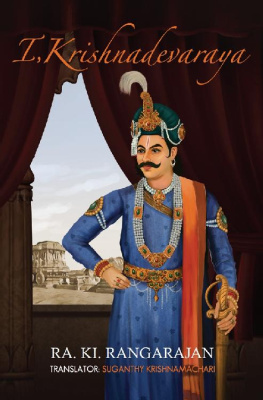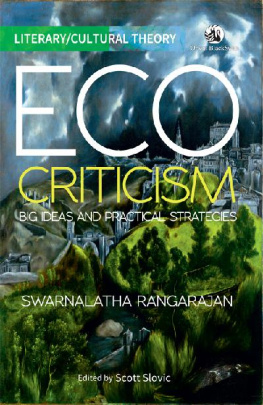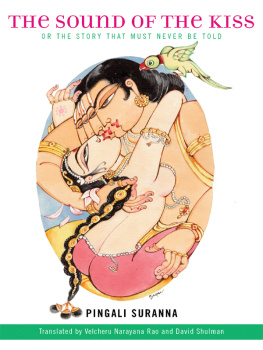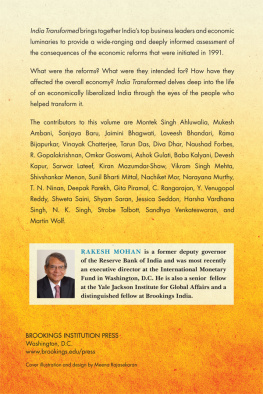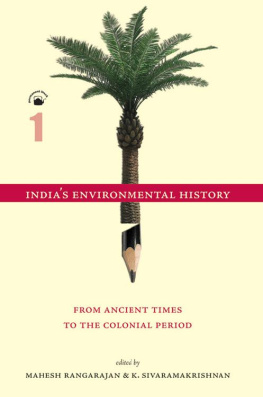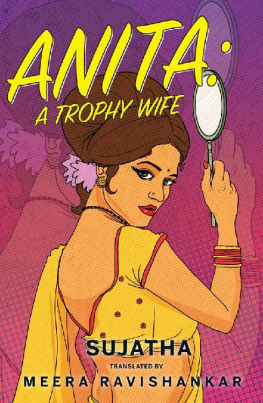westland ltd
I, KRISHNADEVARAYA
(Naan Krishnadevarayan)
Ra. Ki. Rangarajan, who was with Tamil magazine Kumudam for forty years, left a mark on almost every genre of Tamil literature. He even wrote on the occult. He was perhaps the author with the most pseudonymsas many as ten! He also tried his hand at translations, capturing the flavour of Sidney Sheldon and Jeffrey Archer for the Tamil reading public. His translation of Henri Charrieres Papillon was serialised in Kumudam and was a huge hit. Ra. Kis short stories with a surprise twist in the end were compiled under the title Twist Kadaigal , and were inspired by Jeffrey Archers A Twist in the Tale . Ra. Ki.s magnum opus was Naan Krishnadevarayan .
Suganthy Krishnamachari is a Chennai-based journalist, and has written articles on history, temple architecture, Sanskrit, mathematics, literature and music. She has written a series of books for schoolchildren on mathematics and English grammar. One of her short stories, published in a leading newspaper, is being used by an educational publishing company which is bringing out two English Language Teaching (ELT) series for school students. Another story was translated into Tamil some years ago, and published by an educationist in a magazine he edits.
I, KRISHNADEVARAYA
(Naan Krishnadevarayan)
Ra. Ki. Rangarajan
Translated by
Suganthy Krishnamachari
westland ltd
61, II Floor, Silverline Building, Alapakkam Main Road, Maduravoyal, Chennai 600095
93, I Floor, Shamlal Road, Daryaganj, New Delhi 110002
First e-pub edition: 2017
First published by westland ltd 2016
Copyright Ra. Ki. Rangarajan 2016
978-93-86224-45-3
All rights reserved
Typeset in Adobe Garamond Pro by SRYA, New Delhi
This book is sold subject to the condition that it shall not by way of trade or otherwise, be lent, resold, hired out, circulated, and no reproduction in any form, in whole or in part (except for brief quotations in critical articles or reviews) may be made without written permission of the publishers.
C ONTENTS
This piece of historical fiction by Ra. Ki. cannot be bracketed with other historicals. Even today, historicals in Tamil are written in the style followed by Kalki, Sandilyan and Vikraman. You just have to read one or two of them to know what to expect. Long sentences, difficult Tamil, spies, horses, women, Chola kings, or failing that, Pandya kings, one or two Pallava kings (but definitely only Tamil kings), footnotesthese are the unvarying features of historicals in Tamil. Ra. Ki. has broken with this tradition. That is the first praiseworthy feature of this book.
This is the first time a historical in Tamil has been told in the first person. This story is about a Telugu/Kannada king, whose court was dominated by Brahmins. And the story begins with the king writing a few short sentences in Tamil:
This is my maiden attempt in Tamil. So this work is unlikely to have either a felicitous use of words or a lyrical style. I am writing this work in colloquial Tamil. And even that has been possible only because of my association with poets. Reading Villiputturars Bharatam many times has helped. Tamil poet Veerakavi, the poet who is well known for his extempore poems, and who wrote Harishchandra Venba , is my friend.
It is hard to tell if these are Krishnadevarayas words or Ra. Kis.
There is always a debate about how much history to include in a work of historical fiction. Historical accounts are few and far between, and are not always complete. The author has to fill in the gaps. That is a great challenge. And when trying to fill in the gaps, the author must not assert this is what happened. He must only suggest that this is what could have happened.
With this in mind, Ra. Ki. indicates how Krishnadevaraya could have picked up Tamil. Further exploration of the possibility of the king having learned Tamil becomes impossible, because the story picks up momentum right away. He has also managed to bring in Tirumangai Azhvars verses and also some Sanskrit mantras and slokas.
The hero of the story was a famous king. When he tells his story, the author faces many difficulties. The author cannot keep away from the king. Even when other people have to be written about, it has to be in such a way that either the king has heard of them, or the circumstances are such that he might have heard of them. The kings descriptions of himself have to be moderate. Ra. Ki. has managed to surmount all these difficulties. His experience with the magazine Kumudam has helped, because its editor S.A.P. encouraged Ra. Ki. to try his hand at all genres. This is the second praiseworthy element about this book.
This is the first Tamil historical to be written in the first person. Ku. Pa. Ra. wrote a few short stories in the first person. Even in English, I think the only historical in the first person is I, Claudius , where the Roman emperor Claudius tells his story. It is not necessary that historicals should be told in a stilted style. As long as there are no anachronisms, I dont think an author needs to resort to an old fashioned style of writing for historicals, and Ra. Ki. has proved this through this book.
After John Fowles wrote The French Lieutenants Woman , many English historicals began to follow his informal style of writing. In the same way, Ra. Ki. too is a pioneer. He has ushered in a new style of writing historicals.
It was getting dark. Was a storm really brewing? Or was a storm of emotions tormenting me? As I put some distance between me and the battlefield, the smell of corpses that were beginning to decompose became more and more faint, and there were fewer vultures circling the sky. It was only after a long time, that I realised that I was walking along the banks of the river Krishna. The waters of the river flowed furiously, and the image of the moon in the waters quivered.
I couldnt see the opposite bank of the river. But I had the illusion that I could see the village, Venkata Thathayyas matha, Chinnadevi at the entrance to the matha, welcoming me with extended hands.
We too have the same illusion upon reading this passage, and that is the third praiseworthy feature of this book.
Ra. Ki. has given us a list of the books he has consulted. He has read almost a hundred books; he has consulted many scholars; he has even seen Telugu films about Krishnadevaraya. With so much research behind a novel it is hard to resist the temptation to show off ones reading. But, Ra. Ki. has not fallen prey to such a temptation. He has brought devadasis, ministers and hundreds of ordinary people into his story and spun his tale around them. Among them, Thirumala Devi, whom the king marries out of political necessity and Chinnadevi, whom he marries for love, stand out.
By asking me to write a foreword for this book, Ra. Ki. has given me the joy of reading his well-written novel. My thanks to him for this.
S UJATHA
Readers expect novelty from an author. Ra. Ki. Rangarajan, who has written many books, is an author who has understood what readers want. He has now offered to his readers this story titled Naan Krishnadevarayan .
Krishnadevaraya was a genius, a king who never knew defeat. His contributions to religion, culture, to the countrys progress and to economic development are immense. Inscriptions referring to him bring out his greatness. Many foreigners have given glowing accounts of his reign. A bronze likeness of this king and his two queens Thirumala Devi and Chinnadevi can still be seen in the Tirumala temple. The temple towers of Hampi, Kanchipuram and Chidambaram are testimony to his contributions.


